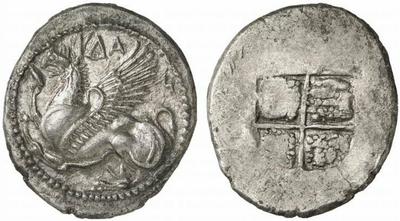Abdera, silver, tetradrachms (492-449/8 BCE)
From SILVER
492 BCE - 449/8 BCE Silver 40,071 kg
Description
| ObverseInscription or printing placed on the obverse.: | ΔΑΜ (Greek).Griffin seated left, with open wings and both forelegs raised, above to left, ΔΑΜ. |
| ReverseInscription or printing placed on the reverse.: | Quadripartite incuse square. |
Mint and issuing power
| MintIdentifies the place of manufacture or issue of a numismatic object.: | Abdera | Ancient regionAncient region.: | Thrace | Modern countryModern country: Greece | AuthorityIdentifies the issuing power. The authority can be "pretended" when the name or the portrait of X is on the coin but he/she was not the issuing power. It can also be "uncertain" when there is no mention of X on the coin but he/she was the issuing power according to the historical sources: |
Chronology
| FromIdentifies the initial date in a range assigned in a numismatic context. | 492 BCE | toIdentifies the final date in a range assigned in a numismatic context.. | 449/8 BCE | PeriodTime period of the numismatic object.: Archaic and Classical |
Physical description
| MetalThe physical material (usually metal) from which an object is made.: | Silver |
Median weightMedian of the weights of numismatic objects (in grams). in grams | 14.85 | DenominationTerm indicating the value of a numismatic object. Examples: tetradrachm, chalkous, denarius.: | tetradrachm |
StandardStandard.: |
Obverse dies distribution
| FrequencyFrequency of specimen in distribution. ᵖ | Number of obversesNumber of obverse dies. ᵖ (o) | % (o) | Number of coinsNumber of coins. (n) | % (n) | Die nameName(s) of the die(s). |
| 1 | 52 | 64.2 | 52 | 32.91 | 51, 53, 58, 59, 60, 61, 65, 69, 70, 71, 73, 74, 75, 76, 77, 78, 85, 86, 87, 88, 89, 90, 93, 96, 97, 98, 106, 107, 109, 110, 115, 116, 117, 121, 122, 125, 128, 130, 131, 132, 134, 138, 141, 142, 143, 145, 146, 147, 148, 149, 150, 151 |
| 2 | 17 | 20.99 | 34 | 21.52 | 52, 54, 64, 84, 91, 92, 108, 112, 126, 127, 129, 133, 135, 136, 137, 140, 144 |
| 3 | 4 | 4.94 | 12 | 7.59 | 57, 68, 94, 124 |
| 5 | 1 | 1.23 | 5 | 3.16 | 123 |
| 6 | 2 | 2.47 | 12 | 7.59 | 114, 119 |
| 7 | 1 | 1.23 | 7 | 4.43 | 95 |
| 8 | 2 | 2.47 | 16 | 10.13 | 66, 111 |
| 10 | 2 | 2.47 | 20 | 12.66 | 113, 118 |
| Total | 81 of 81 | 100 | 158 of 158 | 99.99 |
Reverse dies distribution
no distribution is available
Quantification
| Number of obversesNumber of obverse dies. ᵖ (o) | 81 | Number of singletons (o1)The number of singleton coins. ᵖ | 52 |
| Number of reverse diesNumber of reverse dies. (r) | NC"NC" is not a number. | Number of coinsNumber of coins. (n) | 158 |
| Coins per obverse dieNumber of coins per obverse die. (n/o) | 1.95 | Coins per reverse dieNumber of coins per reverse die. (n/r) | |
| Reverse per obverse ratioRatio of obverse dies divided by reverse dies. (r/o) | Percentage of singletons (o1)number of coins (n) divided by the number of singletons (o1) ᵖ | 64.2 % | |
| Original number of dies (O) (Carter 1983 formula)The estimation of the number of coins according to Carter 1983 ᵖ | 134.92 | Coins struck if 20,000 as average productivity per dieCoins made if the average productivity for obverses (according to Carter) is 20,000. ᵖ | 2,698,400 |
| Original number of dies (O) (Esty 2011 formula)The estimation of the number of coins according to the singleton formula in Esty 2011 ᵖ (O) | 166.21 | Survival rate if 20,000 as average productivity per dieSurvival rate if average productivity is 20,000. ᵖ | 0.00006 |
| Coverage (o = % of O) (Esty 1984 formula)Esty 1984 - coverage (% of O) ᵖ (o = % of O) | 67.09% | Die productivity if survival rate 1/2,000Average productivity if survival rate is 1/2,000. ᵖ | 2,342.13 |
| Weight of silver (in kg) if 20,000 coins per die (O = Carter formula)Carter 1983 * Median weight * 20000 (*10 if gold or electrum) ᵖ | 40,071 kg <br /> 40,071 kg | Die productivity if survival rate 1/5,000Average productivity if survival rate is 1/5,000. ᵖ | 5,855.32 |
Remarks
